AMD’s New EPYC 7F52 Reviewed: The F is for ᴴᴵᴳᴴ Frequency
by Dr. Ian Cutress on April 14, 2020 9:45 AM EST- Posted in
- CPUs
- AMD
- Enterprise
- Enterprise CPUs
- EPYC
- SP3r2
- CPU Frequency
- Rome
- 7Fx2
CPU Performance: Rendering and Synthetics
For the rest of our CPU tests, we’re using a mix of rendering and synthetic workloads. This is slightly different to our previous server reviews, due to some adjustments, and we hope to be running something similar to our standard server workloads in the near future.
All CPUs are run with SMT/HT enabled.
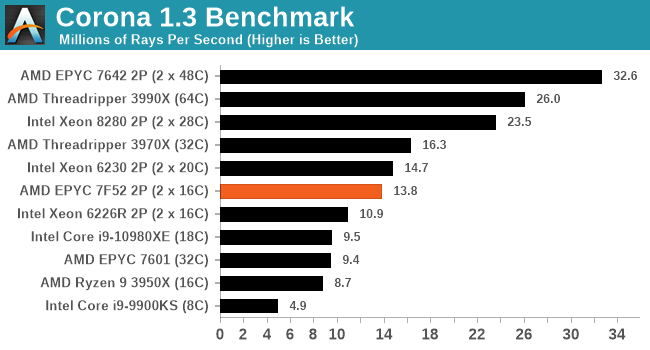
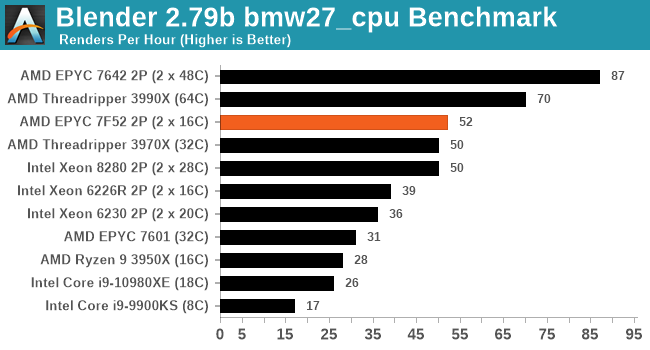
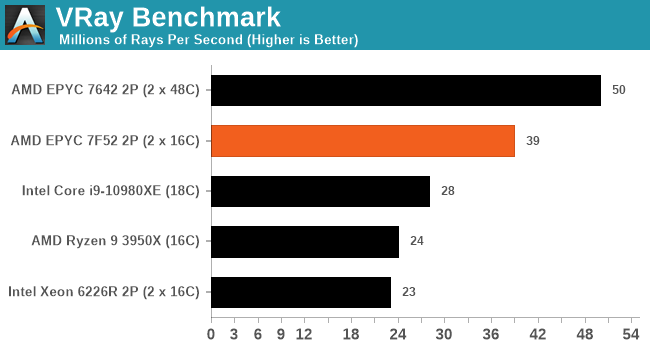
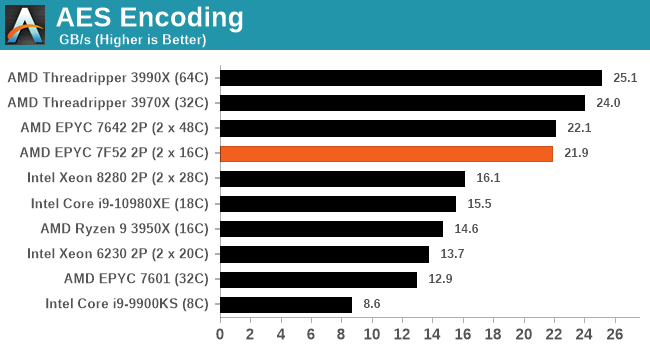
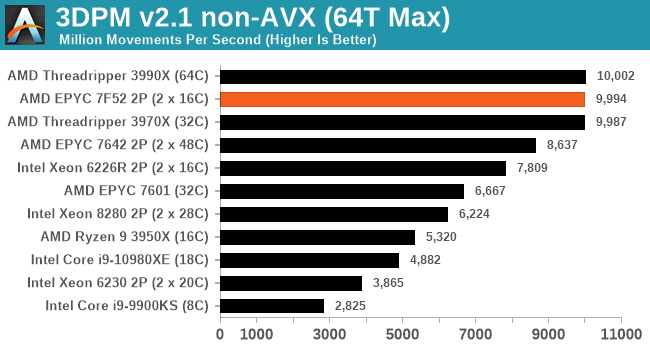
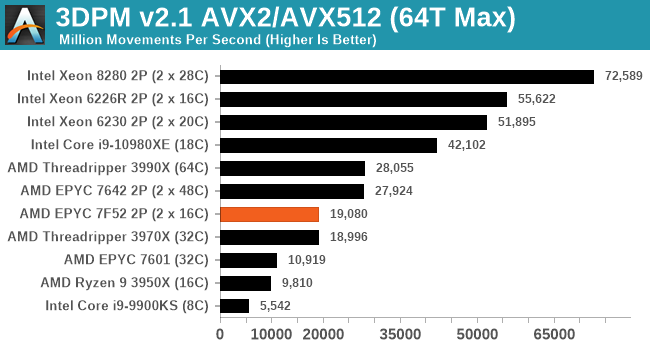
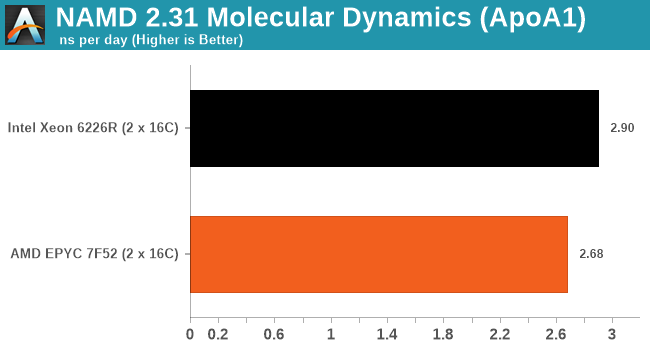

Even with the addition of a socket-to-socket in the mix, the dual 7F52 setup scores up to +100% in some benchmarks over the previous generation EPYC 7601. Against Intel’s latest 16-core Cascade Lake Refresh hardware, the AMD takes a sizeable lead in most benchmarks (except notably AVX512), which is perhaps to be expected given the price difference and power difference. What is interesting is how in certain workloads, the 2P 7F52 setup can make a reach up for the Xeon 8280s, despite the 8280s being 3x the cost each.










97 Comments
View All Comments
eastcoast_pete - Tuesday, April 14, 2020 - link
Thanks Ian! Two questions: 1. Could you and some of your readers give specific examples of applications for which these high frequency CPUs are of great interest?2. Any recent moves by Intel to make software developers use AVX512 even more, basically whenever it would make any sense?
The reason I am asking the second question is that this seems to be the last bastion Intel holds, almost regardless of CPU class. Except for AVX512, AMD is beating them in price/performance quite badly, now from servers to workstations to desktop to mobile.
schujj07 - Tuesday, April 14, 2020 - link
DB servers are one place where you want a fast CPU. SAP HANA for example loves frequency and RAM. I've seen PRD systems with all of 16CPUs but 1.5TB RAM.DanNeely - Tuesday, April 14, 2020 - link
AVX is a compute feature. Rendering and math heavy scientific/engineering workloads are where it'd shine. Databases, typical webservers, and most other 'conventional' business related software don't care.Shorty_ - Thursday, April 16, 2020 - link
Web serving is another place where frequency really helps. I run threadrippers with ECC UDIMM for php hosting for this express reasonMikewind Dale - Tuesday, April 14, 2020 - link
Unfortunately, this breaks AMD's trend of being cheaper than Intel. A 20 core Xeon Xeon Gold 5218R boosts up to 4.0 GHz and costs $1273. This new EPYC is only 16 core, boosts only up to 3.9 GHz, and costs $3100.Usually, AMD is cheaper than Intel, but this seems to be an exception. A pity.
Fataliity - Tuesday, April 14, 2020 - link
That's because its a specialized processor. If you are buying one of these, you won't be worried about the price.To get that much cache, they are using 6-8chiplets. So as many as their top of the line products. So yeah, its going to cost more because theres more silicon.
schujj07 - Tuesday, April 14, 2020 - link
The 5218R that you referenced isn't what the 7F52 is competing against. With a base clock of 2.1GHz the 5218R isn't a frequency optimized part. Most of Intel's CPUs have high boost clocks and middle of the road base clocks. The actual competition is the 6246R which has a 3.4GHz base and 4.1GHz boost clock. These high base clocks are for sustained performance in a given scenario.MFinn3333 - Tuesday, April 14, 2020 - link
That’s is also because it has about 12x as much L3 cache per CPU core. A combined 256MB vs 30MB cache size speaks for itself.edzieba - Tuesday, April 14, 2020 - link
It's down to two design choices: process choice, and core choice.AMDs hands are somewhat tied when it comes to process choice. They get what TSMC has on offer, and what TSMC has on offer is geared towards mobile devices because that's where the volume market is. The high-performance variants are variants, rather than the baseline.
But even in general, as you shrink your process from 21nm on down, it gets harder and harder to clock up. Gate oxide thickness hit its limit generations ago, which is why gate voltage has remained near constant (~1.1v) for so long. This is only going to get harder as processes shrink further while being stuck with the constant gate oxide thickness but trying to cram closer together without interfering.
In AMD's hands is the design goal of cramming as many cores as possible in. Great for multi-core workloads, but not so great for single core speed. Getting CPUs to clock higher means using multiple transistors per gate (2-3 or even more as processes shrink), and AMD figured they may as well use these transistors for more cores instead of faster cores. The obvious downside is the difficulty in getting Zen cores to even approach 5GHz (with Zen 2 being notable for getting above 4GHz without overkill cooling), and that any workloads that do not span beyond one thread leave those transistors sitting idle.
twtech - Tuesday, April 14, 2020 - link
On the 7H12 - Dell offers it in their EPYC servers, such as the R7525. It's currently about a $375 upgrade over the 7742.